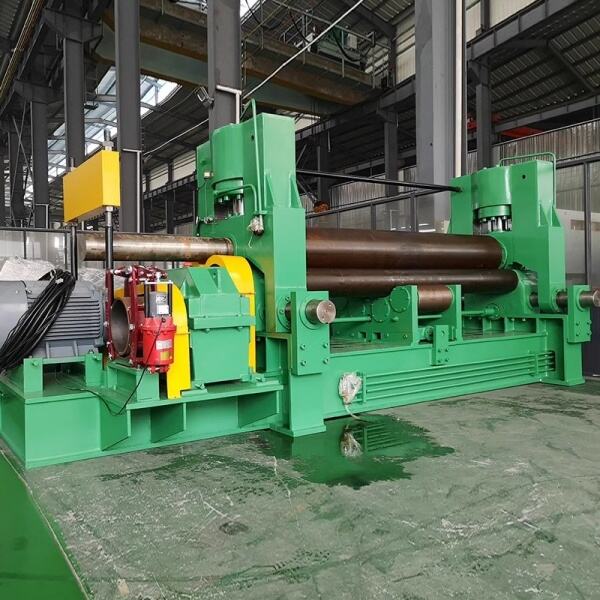Understanding the Benefits of Rolling Machines in Sheet Metal Fabrication
Introduction to Rolling Machines in Sheet Metal Fabrication
What are Rolling Machines?
Rolling machines, also known as roll formers, play a vital role across the metal fabrication sector. Basically, these machines have multiple rollers that guide metal stock through them. What they do is pretty straightforward yet important: they squeeze and mold raw metal into thinner, consistent sheets. This process creates materials needed for countless applications throughout different sectors including cars, planes, buildings, and other structures where uniform metal sheets are required.
Historical Overview of Rolling Machines
Rolling machines started making their mark around the middle of the 1700s thanks to Henry Cort's invention. What Cort came up with was pretty revolutionary for its time, boosting steel output so much that mills could crank out roughly 15 times as much metal compared to older techniques. Since then, these machines have gone through all sorts of changes over the years. Modern versions boast much better accuracy and handle a wider range of tasks, which is exactly what the sheet metal industry needs as it keeps expanding and demanding higher quality products at faster rates.
Importance of Rolling Machines in Fabrication
Rolling machines are indispensable in modern fabrication processes. They enable manufacturers to achieve consistent thickness and material properties, which are essential for product quality and performance. The ability to produce large volumes of uniform sheet metal quickly contributes to lower manufacturing costs and increased productivity.
The Process of Sheet Metal Production Using Rolling Machines
Heating and Preparing Raw Metal
Raw metal needs to go through heating before anyone can start rolling it. Industry workers typically heat the material in large furnaces until it becomes liquid enough to work with. Once hot enough, they pour this molten metal into long, thin molds that look something like giant candy bars. These molds help shape the metal while it cools down and hardens again. Getting this step right makes all the difference later on when trying to form sheets or other shapes during actual rolling operations. Without proper preheating and molding, metals would crack or break instead of bending smoothly under pressure.
The Role of Rollers in Shaping Metal
After cooling down properly, the ingot can finally go into the rolling machine's roller system. When the ingot passes between these rollers, they squeeze it flat, making it thinner each time it goes through. The process keeps going until we get the desired thickness. Most manufacturers know that adding extra sets of rollers helps create thinner sheets with better consistency across the whole batch. This matters a lot for quality control in production runs.
Post-Rolling Processes: Annealing and Treatment
Once rolling is complete, metals typically go through various treatments afterward. Annealing stands out as one popular method. The process involves heating up the rolled metal again and letting it cool down gradually over time. What does this achieve? Well, it basically gets rid of those pesky internal stresses that build up during manufacturing. As a result, the final product becomes stronger and lasts longer too. These qualities matter a lot when working on projects like structural components or anything else requiring reliable metal performance under stress conditions.
Benefits of Using Rolling Machines in Sheet Metal Fabrication
Increased Production Efficiency
One of the significant advantages of using rolling machines in sheet metal fabrication is the efficiency they bring to the production process. With machines capable of processing large quantities of metal rapidly, manufacturers can significantly reduce production time, meeting tight deadlines and increasing throughput.
Enhanced Material Uniformity
Rolling machines contribute to improved material consistency and uniformity. By maintaining precise control over the rolling process, manufacturers can ensure that every sheet produced meets exact specifications, leading to higher quality products and reduced material wastage.
Flexibility in Metalworking Applications
Modern rolling machines are versatile and can handle various materials and thicknesses. This flexibility allows manufacturers to adapt quickly to changing market demands without requiring significant changes in equipment or processes.
Applications of Rolling Machines Beyond Sheet Metal
Rolling Machines in Structural Fabrication
Beyond sheet metal, rolling machines play a crucial role in structural fabrication. They are used to shape beams and other structural components, allowing for the creation of sturdy and durable frameworks necessary in construction projects.
Uses in the Automotive Industry
In the automotive sector, rolling machines are employed to manufacture various components, including chassis, fuel tanks, and body panels. The ability to produce lightweight yet strong parts is vital for optimizing vehicle performance and efficiency.
Innovative Applications in Aerospace and Medical Fields
The aerospace and medical industries also benefit from rolling machine technology. In aerospace, theyâre vital for producing fuselage components, while in the medical field, they assist in creating precise instruments and devices. The high-quality standards required in these industries make rolling machines a critical asset.
Future Trends in Rolling Machine Technology
Advancements in Automation
As technology evolves, so does the capabilities of rolling machines. Future trends indicate a shift towards increased automation, reducing labor costs and minimizing the risk of human error, resulting in a more efficient production environment.
Sustainability in Metal Fabrication
Sustainability is becoming a significant focus in metal fabrication. Manufacturers are increasingly exploring eco-friendly materials and processes, including the recycling of scrap metal, integrating sustainable practices into rolling machine operations.
Impact of Industry Growth on Rolling Machines
With the sheet metal industry projected to grow, the demand for advanced rolling machines will likely rise. This growth presents opportunities for innovations and advancements, pushing manufacturers to improve efficiency, productivity, and sustainability in their operations.
In conclusion, rolling machines are indeed the backbone of sheet metal fabrication, contributing to efficient processes, material uniformity, and application versatility across various sectors. As the industry continues to advance, embracing automation and sustainability will be key to leveraging the full potential of rolling technology.



